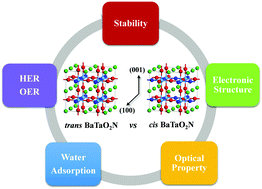First-principles calculations of the structural, energetic, electronic, optical, and photocatalytic properties of BaTaO2N low-index surfaces†
Abstract
We present here the influence of different surface terminations on the electronic, optical, and photocatalytic properties of trans and cis BaTaO2N using density functional theory calculations. For each surface, we consider two complementary terminations exposed with Ba and Ta atoms, respectively. The calculated surface energies suggest that (001) and (100) are more stable than other low-index surfaces. Work functions are distinct for various surface terminations, which can be attributed to the atomic displacements in different directions and degrees after relaxation. We propose that the transferring direction of the photogenerated carriers in BaTaO2N-based heterostructures could be controlled by obtaining the preferred surface termination. The simulated absorption spectra suggest that both trans and cis BaTaO2N exhibit optical anisotropy, which could result from the difference in relaxed crystal parameters along different directions. Dissociative water adsorption on both the (001) and (100) terminations is thermodynamically favorable. The hydrogen evolution reaction (HER) is easier to occur on the terminations exposed with Ta, O, and N simultaneously. The computed overpotentials of oxygen evolution reaction (OER) for trans-(001)-BaO, cis-(001)-TaON, cis-(001)-BaO, and cis-(100)-Ta2O3N are in good agreement with the experimental results. These findings provide important insights into the rational design of (001)- and (100)-oriented BaTaO2N samples for enhanced photocatalytic activity.



 Please wait while we load your content...
Please wait while we load your content...